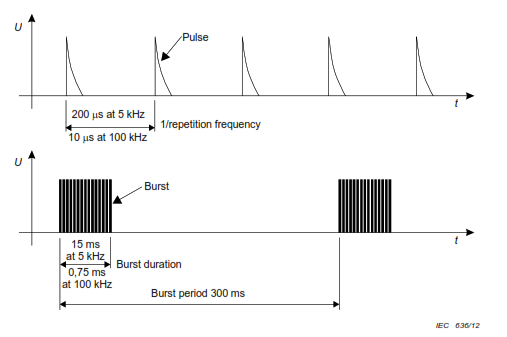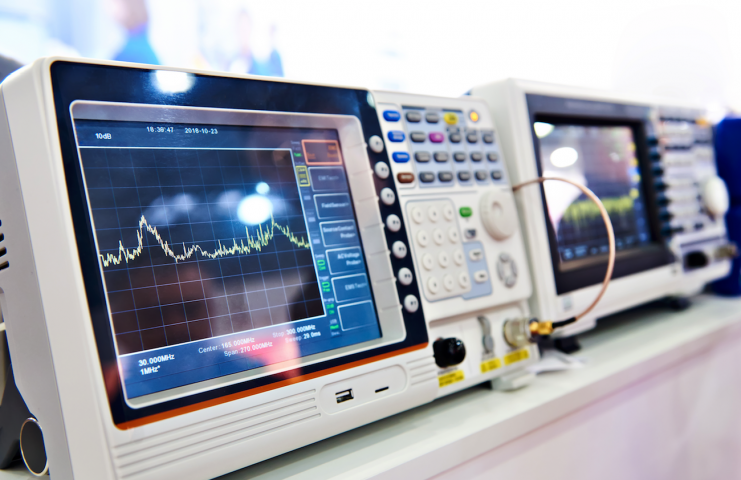IEC 61000-4-4 (Edition 3.0)
Electromagnetic compatibility (EMC) - Part 4-4: Testing and measurement techniques - Electrical fast transient/burst immunity test
EMC Tests are tests that check the electromagnetic compatibility of a device or system. In the Electromagnetic Compatibility Test (EMC Test), it is aimed to operate any electrical and electronic device or system without being affected by and affecting other devices or systems in the environment. EMC Test is generally examined in two categories as Immune EMC Test and Emission EMC Test. Test limit values and test methods specified in the standards used in EMC Test applications may vary according to the features of the device or system.
The Electrical Fast Transient Regime / Sudden Impact Immunity Test specified in the IEC 61000-4-4 standard is one of the Electromagnetic Compatibility (EMC) immunity tests (EMC Test).
IEC 61000-4-4 standard covers electromagnetic compatibility (EMC) immunity rules and test methods for electrical and electronic devices exposed to repeated electrical fast transient regimes.
The purpose of the IEC 61000-4-4 standard is a common and repeatable basis for the evaluation of operating characteristics when electrical and electronic devices are exposed to electrical rapid transient regimes / sudden impacts at the power supply, sign, control and ground ends. to create.
In IEC 61000-4-4 standard, waveform of the test voltage, range of test levels, test devices, verification methods for test devices, test setup, test methods are described.
Electrical fast transient/burst immunity test:
Electrical Fast Transient Test (EFT / BURST Test), when electrical and electronic devices are exposed to disruptive transient regime types such as transient regimes (switching inductive loads, opening and closing of relay contacts etc.) and evaluates its performance.
Electrical fast transient transient pulses (EFT / B) are produced by switching inductive loads. These switching transitions are often referred to as the fast transient regime. The electrical fast transient regime generally does not have a single parameter dependent on the characteristics of the switching contact or the switched load.
The test levels of Electrical Fast Transient (EFT / BURST Test), which is one of the Electromagnetic Compatibility Tests (EMC Test), are as follows;
|
|
Open circuit output test voltage and repetition frequency of the impulses |
|||
|
Level |
Power ports, earth port (PE) |
Signal and control ports |
||
|
Voltage Peak (kV) |
Repetition frequency (kHz) |
Voltage Peak (kV) |
Repetition frequency (kHz) |
|
|
1 |
0,5 |
5 or 100 |
0,25 |
5 or 100 |
|
2 |
1 |
5 or 100 |
0,5 |
5 or 100 |
|
3 |
2 |
5 or 100 |
1 |
5 or 100 |
|
4 |
4 |
5 or 100 |
2 |
5 or 100 |
|
x |
Special |
Special |
Special |
Special |
|
|
“x” can be any level, above, below or in between the others. The level shall be specified in the dedicated equipment specification. |
|||
When performing the electrical fast transient transient pulses (EFT / Burst) Immunity test, the device under test is placed on a reference ground plane and insulated from this plane with an insulating material 0.1 m thick.
Electrical fast transient pulses in the EMC test, an explosion occurs every 300 milliseconds repeated for 1 minute. If the repetition rate of the pulses applied during the test is 5 kHz, the sudden pulse duration is 15 ms (± 20%), if it is 100 kHz, the instant pulse duration is 0.75 ms (± 20%). During the test, both positive and negative polarity (EFT / Burst) pulses are injected. Under these conditions, it is observed whether the device tested is working properly.


